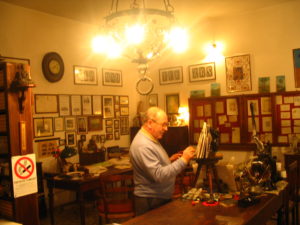____________________________________________________________________________
Note: To make the text larger or smaller, do the following things: If you are right-handed, use the cursor in the following way:
- Holding the control button down, roll your cursor forward to make the text larger or roll your cursor backwards to make the text smaller.
___________________________________________________________________________
A Personal Note: Harriet (my wife) and I jointly share a spirit of adventure. As we have no mortgage, we are free to travel the world financially. We built a handmade house in 1981 on five acres of land 35 kms. out of Brisbane, Australia for minimal money.
See the house / land posts:
OUR HOUSE …. An Overview (http://www.kenaitken.net/1-the-house/)
OUR HOUSE ….The Actual Garden (http://www.kenaitken.net/2-whole-garden/) See the photos of the house and garden and the history of how we obtained rejected materials like from the Supreme Courthouse stone (where the Law Courts are now in Brisbane) …. two loads for nothing in 1980. They dumped 100’s of cubic metres as fill and built a school over the top. The stone was cut out of the Kangaroo Points Cliffs in 1877.
OUR LAND OVERALL (http://www.kenaitken.net/1-the-house/our-land-overall-the-car-shed/)
See these travel posts:
- Ken and Harriet’s Travel posts from 2003 to 2018. I wrote this in April 2020 even though this New Zealand Travel Blog May 2010. (http://www.kenaitken.net/3-our-travels-around-the-world-2/ken-and-harriets-travel-post-from-2010-to-2015/)
- An International Perspective ….. Ken and Harriet’s Travel post from 2003 to 2018. (http://www.kenaitken.net/3-our-travels-around-the-world-2/an-international-perspective-ken-and-harriets-travel-post-from-2003-to-2018/)
___________________________________________________________________________
Note: I would like to share with you through these few words, photographs, and hyperlinked websites, a 3 Dimensional experience as though you were actually there with us. Click on any photograph and it should enlarge to different sizes….. at least half screen or size full screen. It will be clearer in detail than the photo on the post. It will be as if you were really there looking at the actual scene. You are an armchair traveler with us.
If you would also like to see the post in a larger or smaller size, I suggest you follow this procedure: If you right-handed, with your left hand, press down continuously on the Control Function Key with your left hand and with your right hand, move the little cursor wheel either forwards or backwards to make the text in the post larger or smaller.
____________________________________________________________________________
2005: The Italy Trip …. Four-week holiday in Italy ….. from the 17th March to the 18th of April …..
Italy has 2000 ++ years of European History whereas Australia where I come from, has only 240 years of European History when Captain Cook from England sailed into Botany Bay in 1770.
When you start traveling, you realise that Australia is a very small place on the planet. Twenty-two hours away in Italy there are millions of people who barely know that you exist and vice versa.
_______________________________
THE ROMAN EMPIRE in the First Century
The Roman Empire represented the zenith of the best of the human empires. It could adapt any culture on earth into the Roman format. It ran on very enlightened principles and became very wealthy. The British Empire which began to rise in the 1700s till the 1990s, was a 1000 ++ later, was based on those same principles.
Harriet and I personally know about the Roman Empire. We were there on a four-week holiday in Italy in 2005 in mid-March and April. One of the places we went to see was Pompeii. See the very detailed website: www.thecolefamily.com/italy/pompeii for a virtual photographic tour of Pompeii. See all the wonderful photos of Pompeian life before the eruption in 79 A.D. The website is from a Christian perspective and is by Michael S. Cole, M.D. He says: Thanks to the United States Navy, I was stationed near Pompeii in the mid-1980s. My wife Jeannie and I visited the ruins of that ancient city many times. Our first tour was conducted by Tony d’Ambrosio, then a professor of archeology at the University of Naples, later the director of excavation at Pompeii. After studying everything I could find about Pompeii, I served as an amateur guide for many friends and relatives.
See the many posts on the website. Michael further says: the slide show and commentary provided here will give you a glimpse of what you would see and learn if I could personally escort you around the streets, villas, temples, theaters, baths, shops, and forums of Pompeii. As a bonus, I’ve also included photos of many items from the National Archeological Museum of Naples where most of the treasures of Pompeii are housed. If you’re interested, you should check out some of the many books and Web sites from which you can learn lots more than I’ll be sharing with you here.
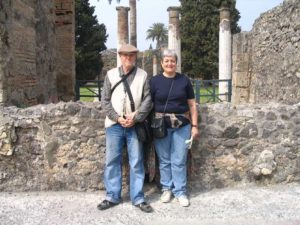
Pompeii is unique as an important archaeological site in the world. Almost every other ancient urban site is simply the remains of a ghost town, long ago deserted by its citizens who carried away with them everything of value. Prior to the eruption of Vesuvius, Pompeii was a thriving city. Then it was buried with so little warning in 79 A.D. that Pompeii was literally frozen in time.
Vesuvius is currently 4,200 feet (or 1,281 meters) high. Some geologists have estimated that it was 6,000 feet high before 79 A.D. If so, that means the top third of the mountain rained down on the surrounding countryside. The prevailing wind at the time blew much of it in the direction of Pompeii.
Some estimate that 20% of the population perished, though it may have been a much higher number if the volcanic gases were excessively toxic. Thousands fled the city in the afternoon darkness, blacker than any Roman citizen had experienced (except in Jerusalem when Jesus Christ was dying on the cross). The falling debris rapidly accumulated in Pompeii to several feet in the streets and on rooftops, making escape impossible for the thousands who sought shelter in their homes.
If we want to know details about what life was like in a Roman city during the first century, I think by studying Pompeii we can get the very best perspective with the least speculation. We can understand how the privileged rich man and the ordinary slave lived from day to day in the Roman Empire during the time when Christianity was beginning to spread throughout the Mediterranean. A better understanding of life in Pompeii, a city with both Roman and Greek influence, can help us to better understand many of the writings of the New Testament.
The Amphitheatre at ancient Pompeii was where sporting events were held. The passion of the people for gladiatorial games was great. The sporting enthusiasm was similar to that provided today by football games (or soccer in Europe). Gladiator helmets, richly decorated with scenes of Greek mythology, were found in the ruins of Pompeii. See the website for an explanation of gladiators: Life of a Gladiator (http://www.tribunesandtriumphs.org/gladiators/life-of-a-gladiator.htm). It was real people fighting it out to a death finish in front of thousands …. For sport.
The amphitheatre at ancient Pompeii is considered to be the world’s oldest known amphitheatres. About the size of a modern football stadium, it had a seating capacity of 12,000 spectators. It was here in 59 A.D. that a riot broke out during a competition with a rival city. The death of many spectators caused the Roman Senate to forbid any games in the Pompeii Amphitheatre for the next 10 years.
_______________________________
TRIP OVER = Flying There on the 17th March
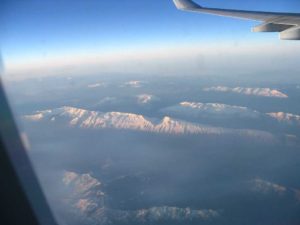
Week 1 = Trip There: Eight hours to Hong Kong (.http://www.discoverhongkong.com/)…… a day in Hong Kong ….. then eleven hours on to Rome.
Week 4 = Trip Back: Eleven hours to Hong Kong …… a day in Hong Kong ….. then eight hours on to Brisbane.
Chinese Markets in Hong Kong ….
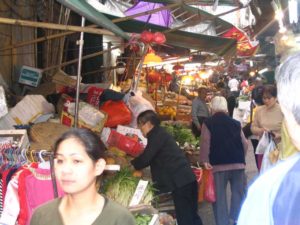
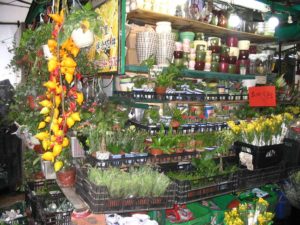

_________________________________________________
Week 1 = Sorrento A train from Rome down to Sorrento on the southern part of Italy on the Mediterranean Sea. The town is very ancient and the church was from the 13th century. See the section in Sorrento ‘The Deep Valley of the Mills’ a wheat grinding mill from 900 A.D. …… we would see this daily as we walked down from our unit. The mill was abandoned in the 1800s as the winds which cooled the Valley were inhibited by the build-up of Sorrento as a town and it became too hot and humid down there. See the post on this website: ITALY HOLIDAY in March / April 2005 ….. SORRENTO: The Valley Of The Mills
(http://www.kenaitken.net/3-our-travels-around-the-world-2/2005-our-italy-holiday/sorrento-the-valley-of-the-mills/)
We also saw:
- The Amalfi Coast and Ravello (http://community.webshots.com/album/72850387JSEIAo) by bus ….. see the 60 stunning photos of Ravello and the Amalfi Coast. See the Post: http://www.kenaitken.net/3-our-travels-around-the-world-2/2005-the-italy-trip/trip-3-italy-holiday-in-ravello-post-6/
- See this website: www.thecolefamily.com/italy/pompeii/ from a Christian spirituality point of view.
Pompeii is unique as an important archaeological site in the world. Almost every other ancient urban site is simply the remains of a ghost town, long ago deserted by its citizens who carried away with them everything of value. Prior to the eruption of Vesuvius, Pompeii was a thriving city. Then it was buried with so little warning in 79 A.D. that Pompeii was literally frozen in time.
- Naples (http://www.italiansrus.com/articles/namnaples.htm), for a day to the National Archaeological Museum which stores a lot of art from Pompeii plus Roman Empire artefacts.
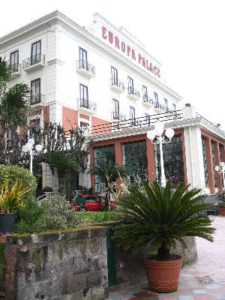
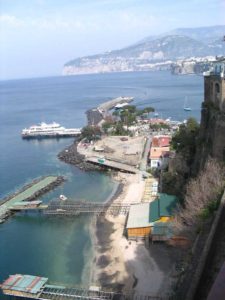
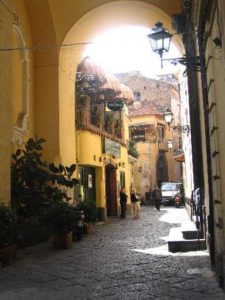
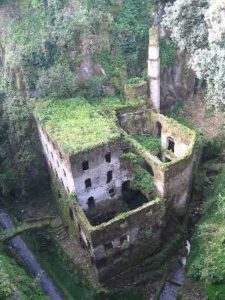
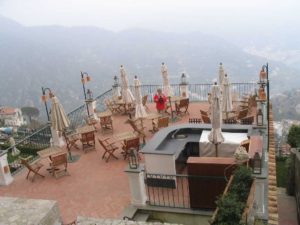
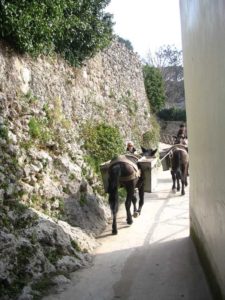
________________________
Pompeii: The Ancient Ruins of Pompeii ….. an original Roman Town buried by 5-6 metres of volcanic ash from Mt. Vesuvius in 76 A.D. You can easily spend a whole day walking the original stone cobbled streets looking at all the houses, temples, public baths, and shop fronts.
See the website and the videos on Pompeii (https://www.history.com/topics/ancient-history/pompeii)
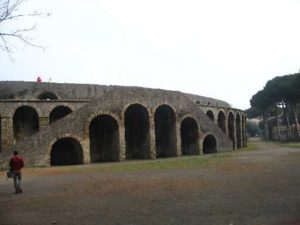
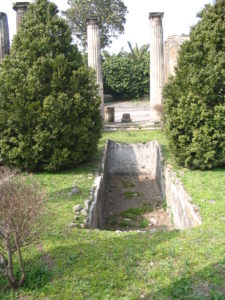
Week 2 = Venice: Walking the streets and canals for a week ….. one of the most beautiful cities in the world from out of the 13th Century …. All of it is like a museum piece ….. but a very impractical city ….. you can be lost in it in the blink of an eye. See the Doges Palace (https://en.wikipedia.org/wiki/Doge%27s_Palace) as well as this website the Doges Palace. (http://www.tickitaly.com/galleries/doges-palace-venice.php)
_________________________________
Venice:
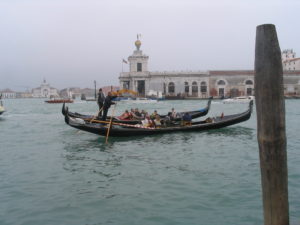
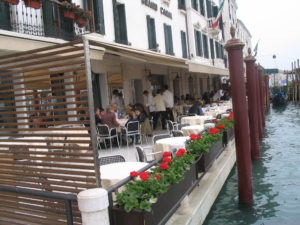
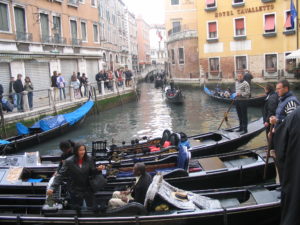
_______________________________
Week 3 = Florence:
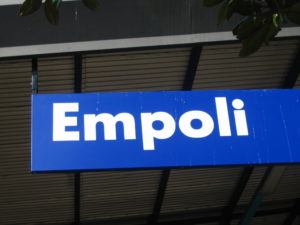
Week 3 = Florence: We stayed in a little town called Empoli (http://www.holiday-apartment-tuscany.net/tuscany_travel_guide/empoli.htm) which was about half an hour by train to Florence ….. then we went out from there every day to a different location:
- Florence for one and 1/2 days. For a wonderful post (completely free) see:
https://www.your-rv-
- Pisa …. see the website on the Leaning Tower of Pisa and The Blog Site of photographs I took.
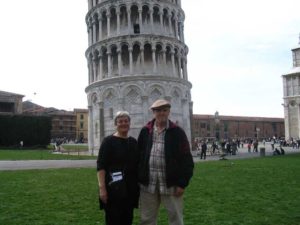
- The new Pisa …we walked through …. If the Tower of Pisa is the bell tower of the Cathedral and its construction began in 1173 and continued (with two long interruptions) for about two hundred years, the new Pisa is anything built in the last 830 years from when we were there in 2005.
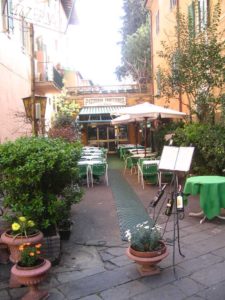
- Siena: Siena , like many other Tuscan hill towns, was first settled in the time of the Etruscans (c. 900 BC to 400 BC) when it was inhabited by a tribe called the Saina.
- San Gimignano The town is called ‘Medieval New York’ from the remaining fourteen stone towers …. the city used to have 70, 300 years ago.
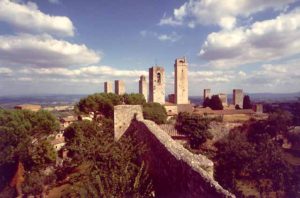
- Lucca …. Lucca is one of Tuscany’s most beloved artistic cities, an unskippable part of any tour of the region. Nicknamed the town of a hundred churches on account of its incredible number of places of worship, it is unique among city-states for having maintained its independence up until 1847.
Historical circumstances demanded that Lucca fortify itself, and so its immense artistic and architectural heritage is ringed by a massive circuit of defensive walls.
Lucca sits in the centre of the Lucca plain, a breathtaking landscape that was sculpted by the river Serchio and is dotted with medieval towns.
Printing Shop in the Town of Lucca.
_______________________________
Vinci (Where Leonardo Da Vinci grew up and lived) …. the museum on Leonardo de Vinci … Leonardo was born in Vinci in 1450 … he was a genius with hundreds of inventions which were way ahead of his time in the 1400’s.
________________________________
Cinquere Terre …. A landscape worth saving …. A man’s park ….. the first image that comes to mind when you think of Cinque Terre is that of rugged mountain terrain, with its deteriorating dry stone walls, built to hold up vineyards. An impressive and unique landscape that has been included on the UNESCO’s World Heritage List. The landscape, which we admire, is the product of collective creativity that was able to overcome the difficulties posed.
It is the local Cinque Terre people, that has spanned over a thousand years. Together these people have worked towards one vision – to live, to produce, and to be part of a community. Over this time, a human chain of men and women transformed this territory with age-old techniques and wisdom and with the naivete’ of poverty, a hard challenge for survival.
There are five ancient fishing villages perched on the edge of the cliffs:
- Riomaggiore, 2. Manarola, 3.Corniglia 4. Vernazza, 5. Monterosso ….. all joined by a railway line and by old walking and donkey trails. We walked up from the train station at the first village of Riomaggiore and saw the ocean and the steep cliffs …… we walked on the easy walk to Manarola …… a rockslide had occurred between Manarola and the third village of Corniglia. We then caught the train up to the last (fifth) village of Monterosso then walked four hours to Vernazza by old walking and donkey trails. ….. the fourth village on the sea …. absolutely beautiful!!
See the Post on this website: ITALY HOLIDAY in March / April 2005 ….. CINQUE TERRE
_______________________________
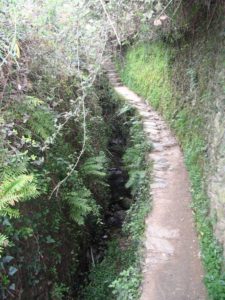
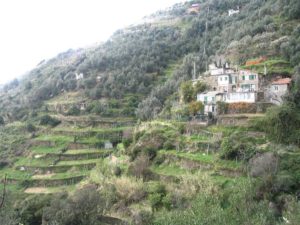
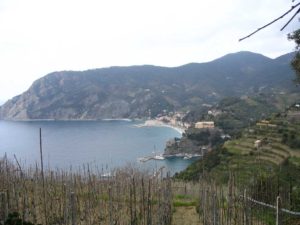
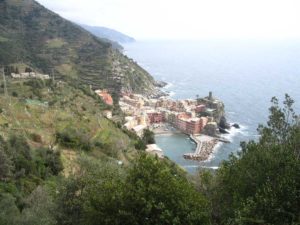
-
Week 4 = Rome: We stayed in a small convent on the edge of St. Peters Square … where over successive days where we saw the Colosseum and walked down the excavated Forum Area where Paul and his 1st Century Christians would have walked down. From the small convent we would walk downstairs after breakfast to see places:
- Peter’s Square itself, St. Peter’s Basilica (http://en.wikipedia.org/wiki/St._Peter%27s_Square)
- The Vatican Museum (http://www.vatican.va/)
- The Palatine plus the Forum Area (First Century) website at: ….. Includes general photos of Rome as well
- Gladiators
A Roman gladiator was an ancient professional fighter who usually specialised with particular weapons and types of armour. They fought before the public in hugely popular organised games held in large purpose-built arenas throughout the Roman Empire from 105 BCE to 404 CE (official contests).
As fights were usually to the death, gladiators had a short life expectancy and so, although it was in some respects a glamorous profession, the majority of fighters were slaves, former slaves or condemned prisoners. Without doubt, gladiator spectacles were one of the most-watched forms of popular entertainment in the Roman world.
- The Catacombs …. One of six around Rome see:
The flip side of Roman Culture was that people’s lives didn’t matter. Hence you have things like these:
-
The Romans would go to take over whole countries and just take them over: England, North Africa, Spain, Europe etc. …. Whether they liked or not …… possibly burn their cities to the ground and take their people back to Rome as slaves as happened in Jerusalem in AD 70.
- Roman culture had a variation on wholesale abortion …. Babies would come to full term …. Then if mothers didn’t want them, they would left by the roadside for wild animals or vultures to eat or throw them in the river. …. Maybe 1 in 3 occurred this way ….. especially girl babies
- Homosexuality was common …. Older men often had young boys as sex slaves
- The passion of the people for gladiatorial games was great. It was real people fighting out to a death finish in front of thousands …. For sport. If certain slaves showed promise, they could go through the gladiator school and provide live sport for thousands in the watching stands ….. to the death with other gladiators or wild animals …. The rewards were great for successful gladiators
- Executed Christians without mercy when they wouldn’t acknowledge Caesar as God …. Fed them to the lions in a public spectacle in the Colosseum or nearby in another sporting complex or burned them as pitched soaked night-time garden candles in the Emperor’s garden
___________________________________________________________________________
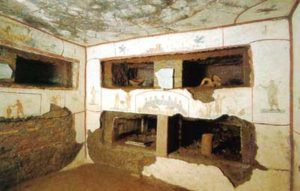
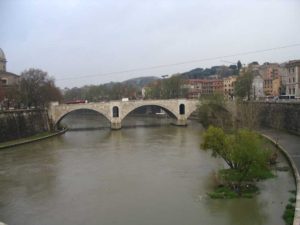
http://theromanempireinthefirstcentury.blogspot.com/

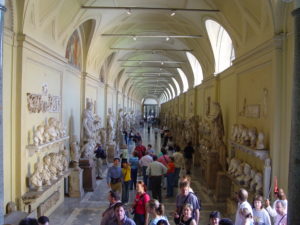
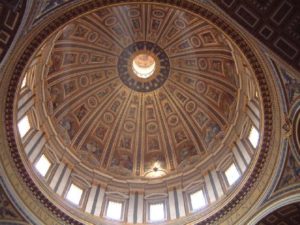
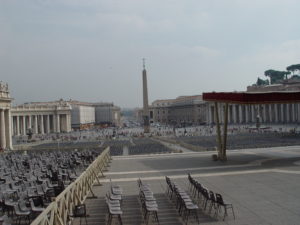

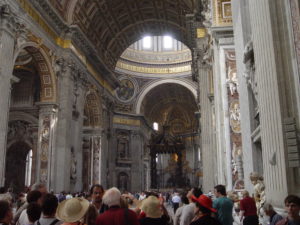
______________________________________________________
The Roman Colosseum …
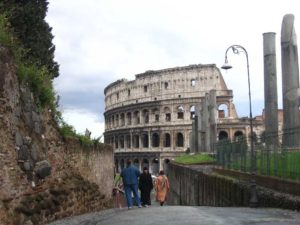
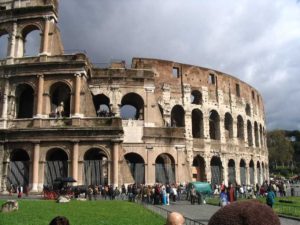
See Rome.info > Roman Colosseum, Coliseum of Rome
The Forum Area ….
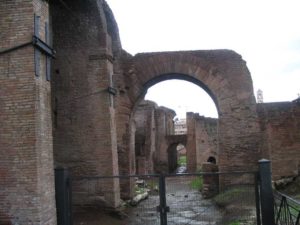
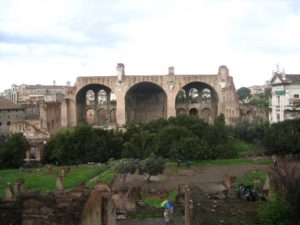
http://earlyrometheforumarea.blogspot.com/
_________________________________________________________________
See the next post ….. This post is hyperlinked even though it doesn’t appear to be:
Trip 3: ITALY HOLIDAY in ….. SORRENTO: The Valley Of The Mills = Post 2
__________________________________________________________________

